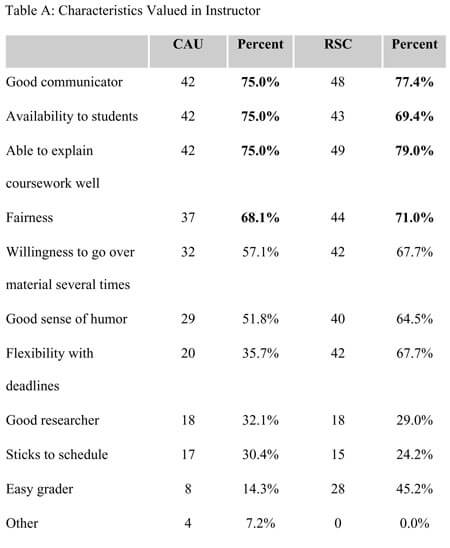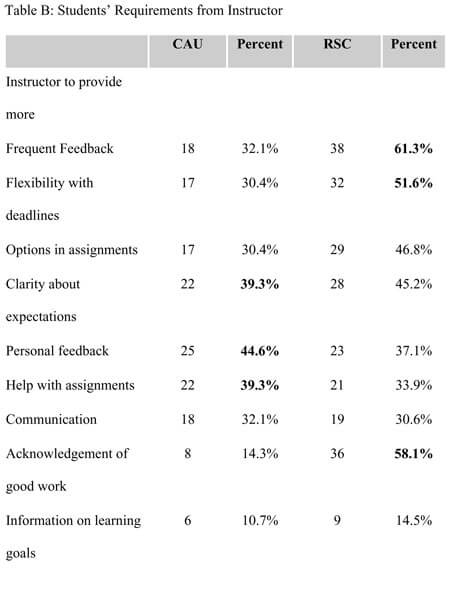Emerging Pedagogies for Uncertain Times: Student and Faculty Perspectives
Published in:
November 20–21, 2009
Clark Atlanta University, Morehouse College, and Spelman College
Atlanta, Georgia
We set out to investigate empirically whether and how the instructional roles of faculty are changing, whether and how students’ instructional needs are changing, if these changes were appropriately aligned to support learning, and if there were differences between students from different institutions in what types of instruction they enjoyed, preferred, or considered to be most effective in helping them to learn. We believed the timing for the study would have had an effect on the data because environmental factors such as the unstable job market for college graduates, the uncertainty that many early career faculty feel about their job security and the current economic depression would affect the answers to the questions that we asked.
Undergirding this descriptive study is a philosophical question about the purpose of undergraduate education and the possibly different ways that this purpose is perceived by students and faculty. The false but much-debated dichotomy of liberal education for intellectual, moral, and personal development in contrast to the more utilitarian goal of preparing students for the world of work, may now have converged as prospective employers are reportedly seeking employees with good critical thinking and writing skills, a broad knowledge base, leadership abilities, integrity, and the ability to work well with others (Hart, 2007). These are exactly the outcomes that are supported by a broad general education. Faculty in this current climate may not have the luxury of choosing one or the other philosophical platform to support their pedagogy; students may be expecting, and employers demanding, that colleges do both – educate broadly and prepare for the job market. Philosophy influences pedagogy and therefore if the goals of education change then teaching practices will also change. Similarly, if the needs and expectations of students who are coming to college are changing over the years then their demands may be instrumental in driving pedagogical change.
Most commonly, references to emerging pedagogy are made in the context of distributed education with hybrid or learner-managed courses, and indeed this is the changing face of instructional delivery in higher education. However, direct instruction is still the dominant mode of facilitation and the pedagogies involved there might also be changing. Because student characteristics have changed over the years and presumably students’ learning needs have also changed, these variations could affect the instructional approaches that faculty take. Added to that, the greater reliance on student ratings in the evaluation of teaching could have introduced a shift towards more student-gratifying behaviors on the part of faculty. It is in this context that we explored, in discussions with colleagues, the question of evolving pedagogies of expediency. These discussions were held during the fall semesters in weekly faculty development workshops. Faculty reported, anecdotally, that they have made gradual shifts to more learner-centered practices than they had previously employed or that they had been exposed to as students themselves.
Data from Faculty
Faculty identified three areas of pedagogical emphasis that appeared to serve their students’ needs; these were expedience, connection, and support. The matter of expediency caused faculty some disquiet. There was a sense that the direction and the depth of learning should not be limited by the practical applications that can be derived from the topic, the relevance to students’ current knowledge, or to job-related factors. Faculty were of the opinion that regardless of students’ interest, some topics were inherently important and should be learned and appreciated for their own sake. On the other hand, faculty recognized the tension in students who were going into debt to pay for their education – they want their education to be useful immediately.
Several faculty reported that they had begun to be explicit in creating actual or virtual learning sub-communities among their students. They were deliberate about setting up working groups and they reported that students benefited from the networks that were formed as a result of these working sub-groups. The primary benefits were social support and peer feedback. Other faculty were intentional about setting up connections between students and the professional communities outside of college by bringing in speakers, supervising internships, and creating service-learning opportunities in the subject area.
Most faculty were conscious of taking more supportive roles in the lives of their students, not necessarily by choice but because students appeared to need it. This support extended beyond intellectual scaffolding in the classroom to the work of planning for post-college experiences, providing motivational and clarification assistance, and helping with social and personal problems.
There seemed to be a general recognition of the changing nature of knowledge acquisition and the reduced emphasis on declarative knowledge in the current information accessibility explosion. As keepers of factual knowledge, we would now be redundant. How do we then position ourselves with respect to facilitating the construction of knowledge? Although information is readily accessible there is increasing room for the facilitation of learning in procedural, conditional, and metacognitive knowledge domains. Faculty are addressing these areas more explicitly and are spending more time giving feedback to students on the development of procedures, on problem-solving strategies and on helping students learn how to learn. Additionally, faculty were being more explicit about their pedagogy. They explained their strategies, outlined how they expected these strategies to help students meet the goals that they have set for learning and they were more open to reflection with students on degree of success of these strategies.
Data from Students
During the fall of 2009, groups of students from two institutions were asked to complete an online survey, The Instructional Effectiveness Questionnaire, which was developed by the researchers for this study. The Instructional Effectiveness Questionnaire is a 25 item self-report instrument with a mixture of closed and open-ended questions that sought student input on four primary areas related to their learning:
- What helped them to learn
- Faculty characteristics or behaviors valued by students
- Student requirements/expectations from faculty
- The types of instruction that they enjoy most
The students were from Clark Atlanta University (CAU) a private, historically black university, in close proximity to downtown of a major city, with 3300+ undergraduate and 600+ graduate students, and from The Richard Stockton College of New Jersey (RSC), a public, liberal arts college in a rural setting, with 7300 undergraduate and graduate students who are predominantly Caucasian.
Of the 121 students (61% of those invited to do so) who completed the survey, 56 were from CAU and 65 from RSC. The students were from classes in psychology, general studies, computer sciences, decision sciences, and biology. The sample was predominantly female (77%) and predominantly upper-class men (85%). The average age of all participants in the study was 22 years (standard deviation 3.7). Approximately one-third planned to go on to graduate studies directly after graduation, another third planned to delay graduate work until later, and the remainder were unsure as to whether they would pursue further formal study.
Forty-six percent of students reported that they contacted their instructors out of class approximately one to three times per semester, 33% sought this contact one to three times per month, and 14% contacted their instructors at least once per week. However frequently they got in touch, most (75%) used e-mail and only 11% went to see faculty during office hours. Although the majority of students used text messaging to communicate socially, they did not use text messaging to communicate with instructors. The students reported that they were well prepared for the world of work (22% said “very” and 64% said “somewhat”) and that life prepared them better (52%) than did school (38%); although most (64%) said they learn more in class than out of class (36%). Almost all (94%) of the participants said that they would like to have more contact with professionals in their field of study.
Results
Students from both institutions appeared to have remarkably similar expectations, values and needs as they relate to learning despite racial, geographic and institutional differences. Overall, there were only minor, non-significant differences between the two groups of students. Although students say they want faculty who are good communicators and who are very available to them, only 11% report that they do make use of office hours for follow up discussions. Both groups of students report that they enjoy discussion most and both said that discussions and interactive exercises are very effective at helping them learn. Lectures were also strongly favored (54%) in helping students learn, but were very low (14%) on the list of enjoyable instructional modalities.
Tables A and B show some of the institution-specific results:

Interestingly, only approximately one third of the respondents (32.1% CAU, 29% RSC) included good researcher as one of the characteristics valued in an instructor; this is contrary to its perceived importance in teaching as well as in research institutions.

The students from CAU prioritized the input that they needed from their instructors differently than the RSC students. These differences were not statistically significant; however, although ‘Feedback’ appeared in the top three of both groups of students, CAU students wanted more personal feedback and RSC students wanted more frequent feedback. If in fact faculty are focusing more on procedural and conditional knowledge than on declarative knowledge in their classes, their role as providers of feedback both frequent and personal is an important one in helping students develop accurate methodologies and algorithms for problem solving. This is one area where faculty perceptions of their facilitation roles and students’ expressions of their learning needs are aligned.
Students from CAU wanted more clarity and assistance and those from RSC more flexibility and acknowledgement from their faculty. Both groups of students rated ‘Information on the learning goals’ lowest of all the possible types of assistance that students need from faculty, although faculty identified this as one of the ways in which they were changing their instruction – sharing and discussing learning goals. This is one area of misalignment between faculty and students.
A summary of the key results as prioritized by the respondents follows.
Type of instruction that is most enjoyable:
- Discussion, problem solving (CAU), fieldtrips (RSC), lecture
Best aids to student learning:
- CAU: Interactive exercises, discussion, lecture, problem solving
- RSC: Discussion, interactive exercises, lecture, field trips
Instructional aids that should be used more often by faculty:
- Study guides, practice exams, real life situations
Most valued faculty characteristics/behaviors:
- Able to explain coursework well, good communicator, fairness, availability to students
What students want/expect from faculty:
- CAU: Personal feedback, clarity about expectations, help with assignments
- RSC: Frequent feedback, acknowledgement of good work, flexibility with deadlines
Method used by students to contact the instructor:
- E-mail, during office hours, walk-in
While this study provides useful insights on students’ perceived learning requirements and expectations in today’s uncertain environment, we must acknowledge the sampling limitations. All these data were from non-random samples and from intact groups of students in several classes. The results from an unbiased sample may unearth a different set of factors and less consistency across institutions.
The best recommendation from these findings is to keep the discussion going, not just among faculty and among students, but between faculty and students; not just within an institution, but among institutions of various types and locations.
References
Cox, R. D. (2009). I would have rather paid for a class I wanted to take: Utilitarian approaches at a community college. The Review of Higher Education. 32 (3): 353-282.
Hart, P. D. (2007). How should colleges prepare students to succeed in today’s global economy? Association of American Colleges and Universities. Retrieved from http://www.aacu.org/advocacy/leap/documents/re8097abcombined.pdf
Mulcahy, D. G. (2008). Towards a new paradigm for liberal education. Lantham, MD: Rowman and Littlefield Publishers Inc.
Spring 2010: Challenge as Opportunity: The Academy in the Best and Worst of Times
